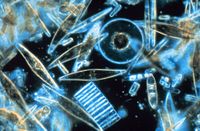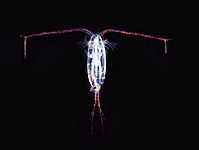Plankton
From Wikipedia, the free encyclopedia
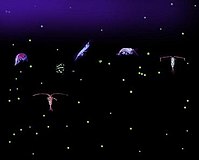
Plankton consist of any drifting organisms (animals, plants, archaea, or bacteria) that inhabit the pelagic zone of oceans, seas, or bodies of fresh water. Plankton are defined by their ecological niche rather than their phylogenetic or taxonomic classification. They provide a crucial source of food to more familiar aquatic organisms such as fish.
Contents |
[edit] Definitions
The name plankton is derived from the Greek word πλαγκτος ("planktos"), meaning "wanderer" or "drifter".[1] While some forms of plankton are capable of independent movement and can swim up to several hundreds of meters vertically in a single day (a behavior called diel vertical migration), their horizontal position is primarily determined by currents in the body of water they inhabit. By definition, organisms classified as plankton are unable to resist ocean currents. This is in contrast to nekton organisms that can swim against the ambient flow of the water environment and control their position (e.g. squid, fish, and marine mammals).
Within the plankton, holoplankton are those organisms that spend their entire life cycle as part of the plankton (e.g. most algae, copepods, salps, and some jellyfish). By contrast, meroplankton are those organisms that are only planktonic for part of their lives (usually the larval stage), and then graduate to either the nekton or a benthic (sea floor) existence. Examples of meroplankton include the larvae of sea urchins, starfish, crustaceans, marine worms, and most fish.
Plankton abundance and distribution are strongly dependent on factors such as ambient nutrients concentrations, the physical state of the water column, and the abundance of other plankton.
The study of plankton is termed planktology and individual plankton are referred to as plankters.
[edit] Functional groups
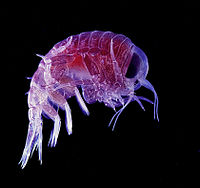
Plankton are primarily divided into broad functional (or trophic level) groups:
- Phytoplankton (from Greek phyton, or plant), autotrophic, prokaryotic or eukaryotic algae that live near the water surface where there is sufficient light to support photosynthesis. Among the more important groups are the diatoms, cyanobacteria, dinoflagellates and coccolithophores.
- Zooplankton (from Greek zoon, or animal), small protozoans or metazoans (e.g. crustaceans and other animals) that feed on other plankton and telonemia. Some of the eggs and larvae of larger animals, such as fish, crustaceans, and annelids, are included here.
- Bacterioplankton, bacteria and archaea, which play an important role in remineralising organic material down the water column (note that the prokaryotic phytoplankton are also bacterioplankton).
This scheme divides the plankton community into broad producer, consumer and recycler groups. In reality, the trophic level of some plankton is not straightforward. For example, although most dinoflagellates are either photosynthetic producers or heterotrophic consumers, many species are mixotrophic depending upon their circumstances.
[edit] Size groups
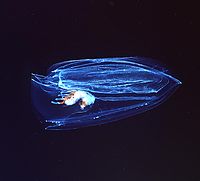
Plankton are also often described in terms of size.[2] Usually the following divisions are used:
| Group | Size range (ESD) | ||
| Megaplankton | > 2×10-2 m | (20+ mm) | metazoans; e.g. jellyfish; ctenophores; salps and pyrosomes (pelagic Tunicata); Cephalopoda |
| Macroplankton | 2×10-3→2×10-2 m | (2-20 mm) | metazoans; e.g. Pteropods; Chaetognaths; Euphausiacea (krill); Medusae; ctenophores; salps, doliolids and pyrosomes (pelagic Tunicata); Cephalopoda |
| Mesoplankton | 2×10-4→2×10-3 m | (0.2 mm-2 mm) | metazoans; e.g. copepods; Medusae; Cladocera; Ostracoda; Chaetognaths; Pteropods; Tunicata; Heteropoda |
| Microplankton | 2×10-5→2×10-4 m | (20-200 µm) | large eukaryotic protists; most phytoplankton; Protozoa (Foraminifera); ciliates; Rotifera; juvenile metazoans - Crustacea (copepod nauplii) |
| Nanoplankton | 2×10-6→2×10-5 m | (2-20 µm) | small eukaryotic protists; Small Diatoms; Small Flagellates; Pyrrophyta; Chrysophyta; Chlorophyta; Xanthophyta |
| Picoplankton | 2×10-7→2×10-6 m | (0.2-2 µm) | small eukaryotic protists; bacteria; Chrysophyta |
| Femtoplankton | < 2×10-7 m | (< 0.2 µm) | marine viruses |
However, some of these terms may be used with very different boundaries, especially on the larger end of the scale. The existence and importance of nano- and even smaller plankton was only discovered during the 1980s, but they are thought to make up the largest proportion of all plankton in number and diversity.
[edit] Distribution
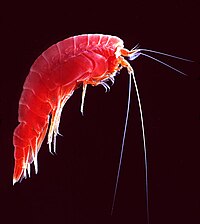
Plankton are found in oceans, seas and lakes. However, the local abundance of plankton varies horizontally, vertically and seasonally. The primary cause of this variability is the availability of light. All plankton ecosystems are driven by the input of solar energy (but see chemosynthesis), and this confines primary production to surface waters, and to geographical regions and seasons when light is abundant.
A secondary cause of variability is the availability of nutrients. Although large areas of the tropical and sub-tropical oceans have abundant light, they experience relatively low primary production because of the poor availability of nutrients such as nitrate, phosphate and silicate. This is a result of large-scale ocean circulation and stratification of the water column. In such regions, primary production still usually occurs at greater depth, although at a reduced level (because of reduced light).
Despite significant concentrations of macronutrients, some regions of the ocean are unproductive (so-called HNLC regions)[3]. Field studies have found that the mineral micronutrient iron is deficient in these regions, and that adding it can lead to the formation of blooms of many (though not all) kinds of phytoplankton[4]. Iron primarily reaches the ocean through the deposition of atmospheric dust on the sea surface. Paradoxically, oceanic areas adjacent to unproductive, arid regions of continents thus typically have abundant phytoplankton (e.g., the western Atlantic Ocean, where trade winds bring dust from the Sahara Desert in north Africa). It has been suggested that large-scale "seeding" of the world's oceans with iron could generate blooms of phytoplankton large enough to draw down enough carbon dioxide out of the atmosphere to offset its anthropogenic emissions (responsible for global warming), although other researchers have disputed the scale of this effect[5].
While plankton are found in the greatest abundance in surface waters, they occur throughout the water column. At depths where no primary production occurs, zooplankton and bacterioplankton instead make use of organic material sinking from the more productive surface waters above. This flux of sinking material, so-called marine snow, can be especially high following the termination of spring blooms.
[edit] Biogeochemical significance
Aside from representing the bottom few levels of a food chain that leads up to commercially important fisheries, plankton ecosystems play a role in the biogeochemical cycles of many important chemical elements. Of particular contemporary significance is their role in the ocean's carbon cycle.
As stated, phytoplankton fix carbon in sunlit surface waters via photosynthesis. Through (primarily) zooplankton grazing, this carbon enters the planktonic foodweb, where it is either respired to provide metabolic energy, or accumulates as biomass or detritus. As living or dead organic material is typically more dense than seawater it tends to sink, and in open ocean ecosystems away from the coasts this leads to the transport of carbon from surface waters to the deep. This process is known as the biological pump, and is one of the reasons that the oceans constitute the largest carbon sink on Earth.
Some researchers have even proposed that it might be possible to increase the ocean's uptake of carbon dioxide generated through human activities by increasing the production of plankton through fertilization, primarily with the micronutrient iron. However, it is debatable whether this technique is practical at a large scale, and some researchers have drawn attention to possible drawbacks such as ocean anoxia and resultant methanogenesis (caused by the excess production remineralising at depth).[6]
[edit] Importance to fish
Zooplankton are initially the sole prey item for almost all fish larvae as they use up their yolk sacs and switch to external feeding for nutrition. Fish species rely on the density and distribution of zooplankton to coincide with first-feeding larvae for good survival of larvae, which can otherwise starve. Natural factors (e.g. variations in oceanic currents) and man-made factors (e.g. dams on rivers) can strongly affect zooplankton density and distribution, which can in turn strongly affect the larval survival, and therefore breeding success and stock strength, of fish species.
[edit] See also
- Aeroplankton
- Algal bloom
- Biological pump
- Gelatinous zooplankton
- Holoplankton
- Iron fertilization
- Meroplankton
- Nekton
- Ocean acidification
- Paradox of the plankton
- Phytoplankton
- Primary production
- Zooplankton
[edit] References
- ^ Thurman, H. V. (1997). Introductory Oceanography. New Jersey, USA: Prentice Hall College. ISBN 0132620723.
- ^ Omori, M.; Ikeda, T. (1992). Methods in Marine Zooplankton Ecology. Malabar, USA: Krieger Publishing Company. ISBN 0-89464-653-2.
- ^ Martin, J. H.; Fitzwater, S. E. (1988). "Iron-deficiency limits phytoplankton growth in the Northeast Pacific Subarctic". Nature 331: 341–343. doi:.
- ^ Boyd, P.W., et al. (2000). "A mesoscale phytoplankton bloom in the polar Southern Ocean stimulated by fertilization". Nature 407: 695–702. doi:.
- ^ Aumont, O.; Bopp, L. (2006). "Globalizing results from ocean in situ iron fertilization studies". Global Biogeochemical Cycles 20 (2): GB2017. doi:. http://www.agu.org/pubs/crossref/2006/2005GB002591.shtml.
- ^ Chisholm, S.W., et al. (2001). "Dis-crediting ocean fertilization". Science 294 (5541): 309–310. doi:. PMID 11598285.
[edit] External links
- COPEPOD: The global plankton database, global coverage database of zooplankton biomass and abundance data
- Plankton*Net, taxonomic database of images of plankton species
- Guide to the marine zooplankton of south eastern Australia, Tasmanian Aquaculture and Fisheries Institute
- Australian Continuous Plankton Recorder Project, Integrated Marine Observing System
